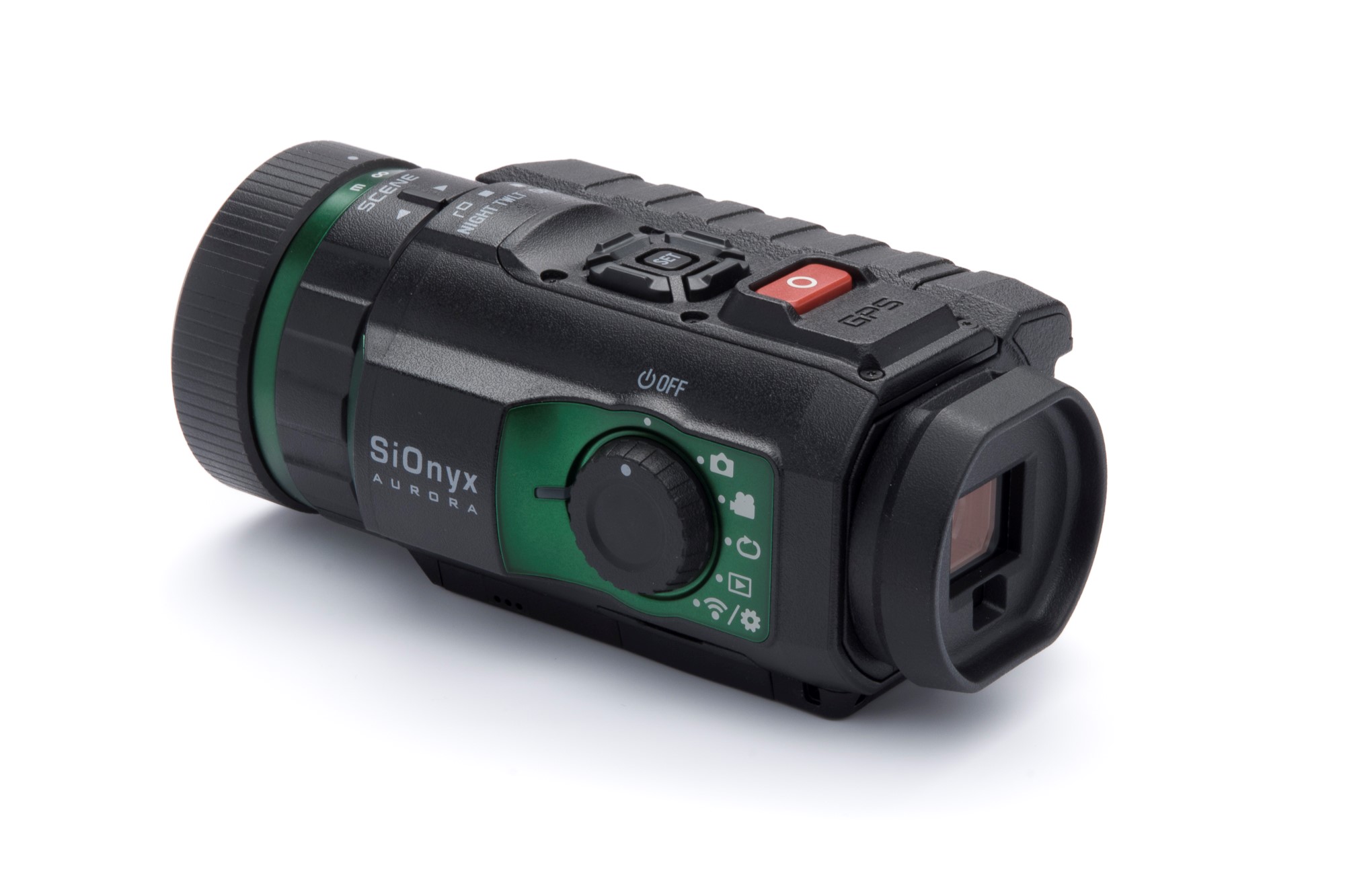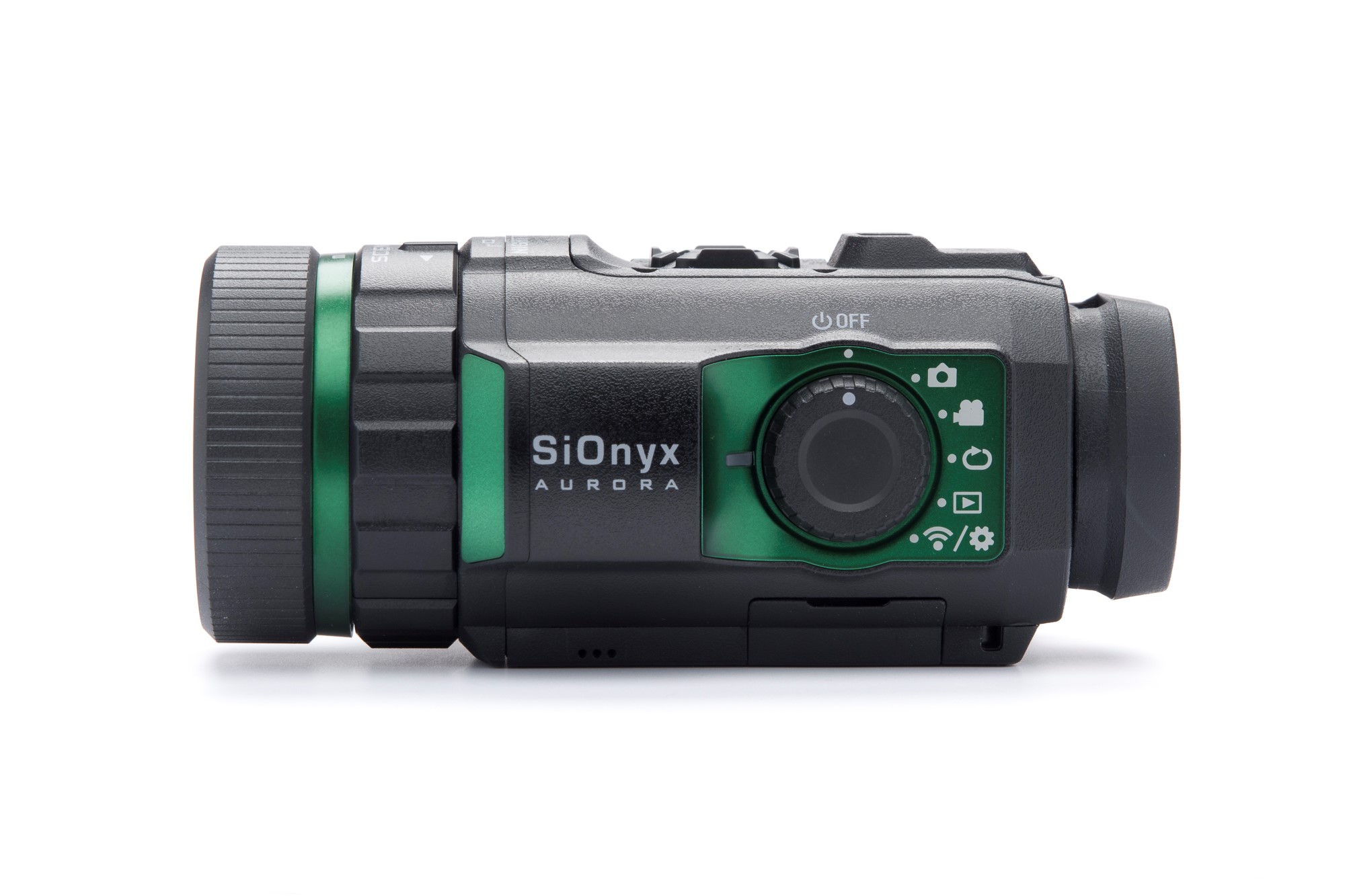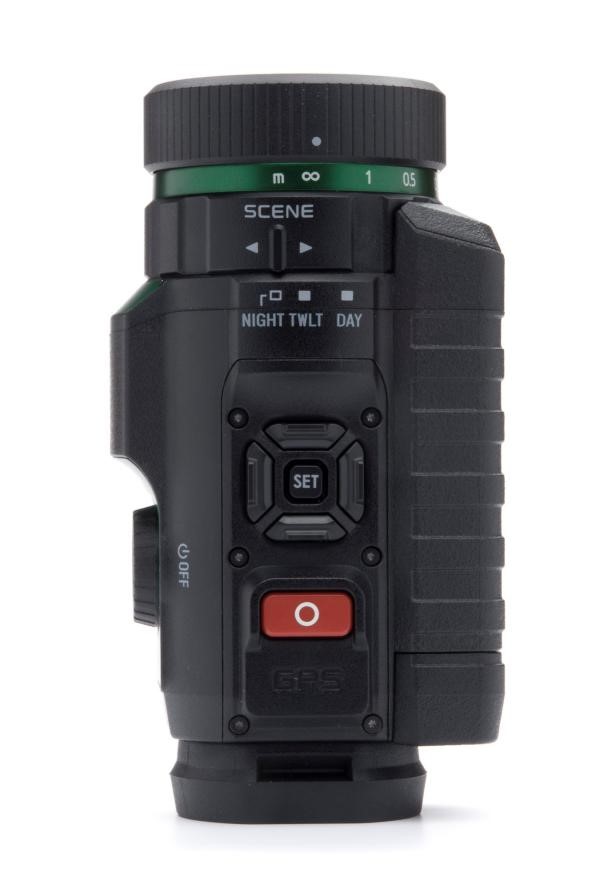SiOnyx Aurora Night-Vision Camera
SiOnyx is a semi-conductor company that produces image sensors for commercial and defense applications. The Aurora is a hand-held video camera with a sensor that intensifies low light.

Key Features
- Active low light sensor
- Color
- Organic Light Emitting Diode (OLED) Zoom
- IP67 rated, water and dust resistant
- Time-elapse, self-timer, or panorama capable
- WiFi phone app remote control
- Image stabilizer, GPS, and digital compass embedded
Mission
The Aurora records day or night time activity or can be used as a real-time viewfinder to navigate in low light situations.
Distinguishing Features
- Color in night mode
- IP67 rated (dust and water-resistant)
Design
The eight-ounce monocular fits in the palm of the hand. It has features and automation similar to other action cameras - but with night vision. The Aurora allows the user to choose most of the settings manually. Set it on auto if you want to have fun, set it on manual if you know about f/stops and such. The best analogy is to think of a professional 35mm camera – while the pros might experiment with manual settings, the rest of us will set it on auto.
Night Vision: How it Works
The objective lens on the left adjusts for distance from the subject, while the ocular lenses on the right adjust focus for the individual’s eye. The active light-gathering technology in the middle is SiOnyx’s strength.
High-resolution night vision requires a large sensor, big pixels, and an equally large lens. With its 1” sensor, .9-megapixel pictures, and 16MM lens, Aurora’s patented technology strikes a balance between functionality, portability, and affordability.
Comparison
Most other action cameras do not have active sensors and achieve low light imagery by simply providing a bigger aperture and leaving the shutter open for prolonged times. A fixed position is essential for this so forget a rolling boat.
Practical Marine Use
The obvious marine application, beyond filming onboard activity, is navigating at night. The Aurora is useful in close quarters around docks, finding a mooring in a crowded anchorage, or in channels where missing a daymark might be disastrous.
The alternative to this camera in these low light instances is to use a spotlight, completely ruining whatever night vision anyone onboard has and more than likely annoying any boaters around.
Product Inspection
Preparing the camera for use
Similar to any other digital device, the Aurora needs to be charged and configured. We quickly set the date and time, activated the GPS, turned on the Chimes feature (plays sounds when confirming various functions) and calibrated the compass. Note, once we turned on the GPS function, we had to go outside to pick up the satellite signals.
It takes 2-3 hours to fully charge the battery. A fully charged battery will provide about 2 hours of shooting video.
Once the basic setup is complete, we can fine-tune other settings depending on what we’re shooting.
Don’t forget to set the viewfinder diopter to your personal vision – just like anyone familiar with a good pair of binoculars knows how to adjust the focus for their personal vision.
Camera settings
The Scene Ring settings adjust the f/stop to pre-set standards for the time of day/light conditions: again, manual f/stop adjustments are possible.
- Night (f/1.4) – full night vision
- Twilight (f/2.0) – approximately one hour before sunrise and one hour after daylight
- Day (f/5.6) – sun or clouds
Shutter speed is the length of time the shutter is open when you take a photo. A faster shutter speed lets in less light and reduces subject motion. There are two shutter settings: Auto and Manual. The camera is set to Auto by default. The Manual setting allows you to adjust the shutter speed from 1/8000″ to 1.5″.
The Overlay function helps the user get better pictures with grid (centering), pitch and roll (straight and level), and focus peak (red highlights on focused objects) options. Turn all the overlay settings on or off with Toggle All.
The electronic view finder (EVF) senses when the user is looking through the viewfinder. The camera can take pictures and videos even if no one is looking through the view finder, as in time-lapse mode. Shut off the EVF to save power when not needed.
The Nightglow option allows the user to select in greyscale, green, or color mode.
Electronic Image Stabilization (EIS) uses electronic processing to stabilize video. When EIS is turned on, it will minimize blurring and compensate for shaking of the camera.
Tips from the manufacturer:
For Day mode video – make sure the camera is in 60 frames per second (fps).
For Twilight mode video – The camera should be in 30fps or lower, 24fps is recommended. Video is possible with normalized color about 1.5 hours after sunset and 1.5 hours before sunrise. We call this First Light/Last Light
For Night mode video – The camera should be set to 24fps or lower. People always ask about the color: why do they see a pinkish color on grass, trees, and plants? The simple answer is that the sensor sees way into the infrared spectrum and picks up colors the eye doesn’t normally see. As an example, the chlorophyll in plants is highly reflective to the infrared (IR) light present in the atmosphere at night.
Gain (Exposure Value) - The left and right NAV button on the top of the camera controls the brightness and darkness of the scene (gain). All night vision devices require some light. The expensive military grade devices use starlight to see. People can’t see very well at that level without some artificial or invisible light. So many folks try to increase the gain of the camera (numbers in the lower left corner of the display, controlled by the NAV buttons). This can be counter-productive in really low light situations, since the camera amplifies noise if it is not seeing light and this makes the image grainy. Often, it is best to decrease the gain to try and get rid of the extra noise under really low light. The manufacturer suggests typically shooting at -0.3 or -0.7 gain levels.
Focus - Autofocus doesn’t work well in the dark so most night vision devices are manual focus. The Aurora has two focus adjustments. Adjust the personal focus back by the viewfinder while looking at the menu until it is sharp. This adjusts for your personal eyesight corrections. There is a focus on the front of the camera depending on the distance from the subject. Finally, the zoom function activated by the toggle buttons on top of the camera works while live viewing, recording, or in playback mode.
Price
Retails for $799, including battery, USB connectivity/charging cables, lanyard, and carry bag.
This tech has not made it to the local marine store yet, but it is available directly from the manufacturer.
https://www.sionyx.com/store/p10/aurora.html
Optional Equipment
WiFi App for IPhone or Android
With the free app, Aurora syncs with your smartphone over WiFi, providing 15 fps live view and full controllability of all the unit’s functionality. In other words, you can mount the camera on the rail, and be back in the cockpit controlling it from the helm.
Explorers Edition $999 (includes items below)
- Aurora color night vision camera
- Custom Aurora Picatinny rail mount
- Illuminator Picatinny rail mount
- Sturdy waterproof case
- 940nm IR Illuminator
- 2 Aurora batteries
- External battery charger for Aurora
- 1 microSD card (32GB)
- Illuminator Rechargeable batteries
- External battery charger for illuminator
- Lanyard
- USB charge/data cable
Observations
The U.S. government restricts the export of certain night vision technology and various states regulate its use. So how is the Aurora sold to the public? The best analogy is to think of the government first allowing the public to use GPS – it wasn’t military-grade precise at first – but it was an instant boon to mariners.
This technology may not replace other tech the way GPS did with Loran, but it would be a good complement to a spotlight, radar, or FLIR (thermal imaging) camera to have onboard. The price for the Aurora is reasonable, and the camera is practical and fun.

